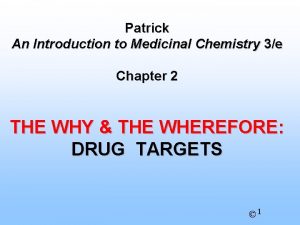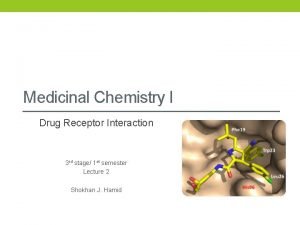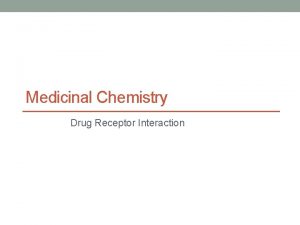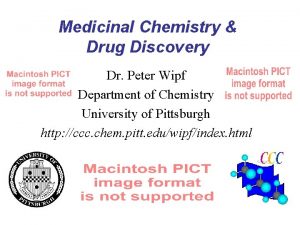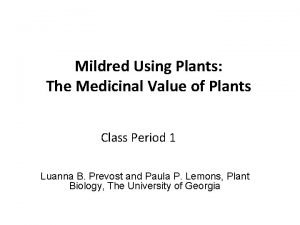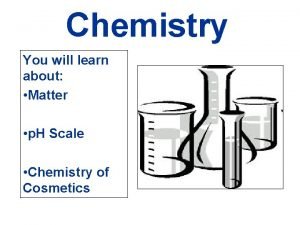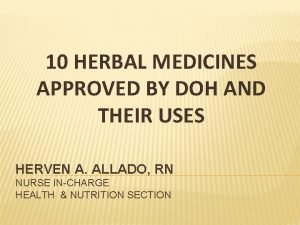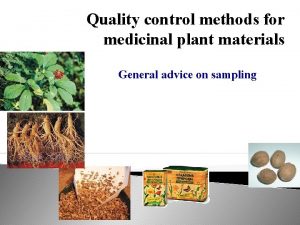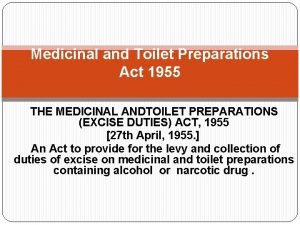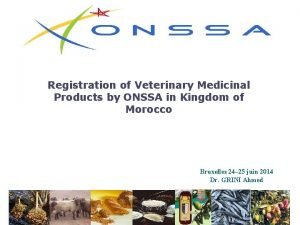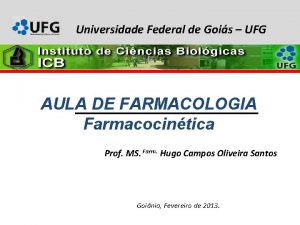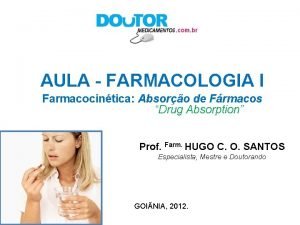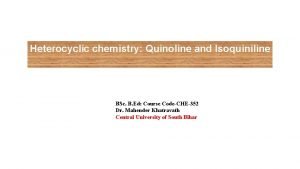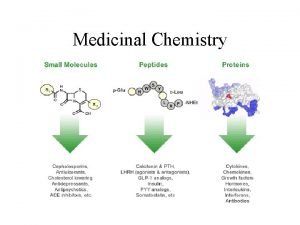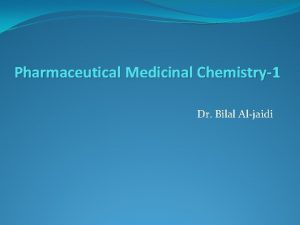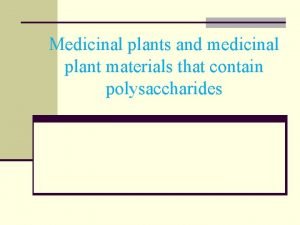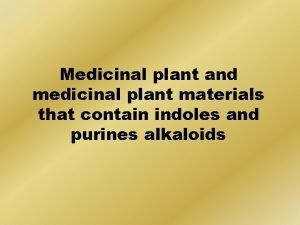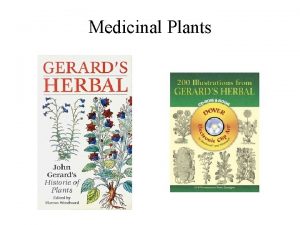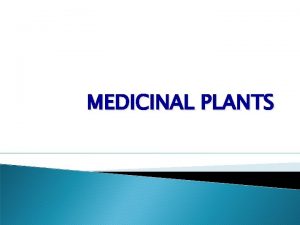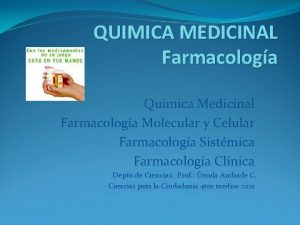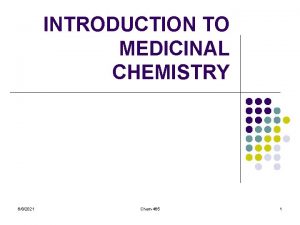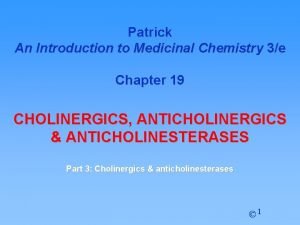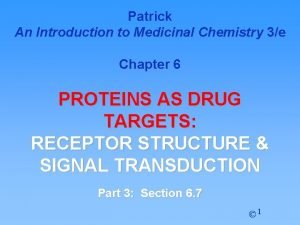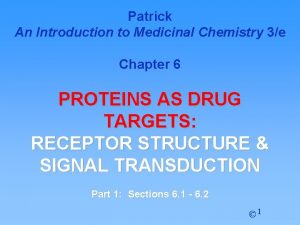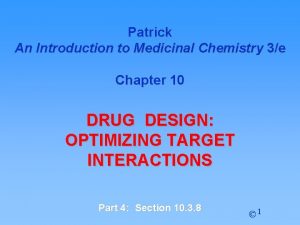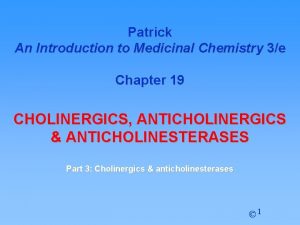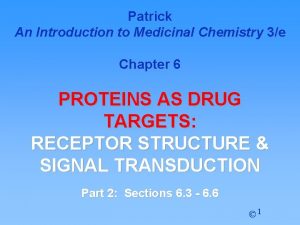INTRODUCTION TO MEDICINAL CHEMISTRY Introduction to Medicinal Chemistry



















- Slides: 19

INTRODUCTION TO MEDICINAL CHEMISTRY

Introduction to Medicinal Chemistry Medicinal chemistry is best to be defined as an interdisciplinary research area incorporating different branches of chemistry and biology in the research for better and new drugs (Drug Discovery). In other words, medicinal chemistry is the science, which deals with the discovery and design of new and better therapeutic chemicals and development of these chemicals into new medicines and drugs. Generally Medicinal Chemists can: • Make new compounds • Determine their effect on biological processes. • Alter the structure of the compound for optimum effect and minimum side effects. • Study uptake, distribution, metabolism and excretion of drugs.

Drug Classification Pure organic compounds are the chief source of agents for the cure, mitigation or the prevention of disease. These remedial agents could be classified according to their origin: • Natural compounds: materials obtained from both plant and animal, e. g. vitamins, hormones, amino acids, antibiotics, alkaloids, glycosides…. etc. ). • Synthesis compounds: either pure synthesis or synthesis naturally occurring compounds (e. g. morphine, atropine, steroids and cocaine) to reduce their cost. • Semi-synthesis compounds: Some compounds either can not be purely synthesized or can not be isolated from natural sources in low cost. Therefore, the natural intermediate of such drugs could be used for the synthesis of a desired product (e. g. semi synthetic penicillins).

Drug Classification Since there is no certain relation between chemical structure and pharmacological activity therefore, it would be unwise to arrange all drugs on the basis of their structures or origin. Thus, it is better to arrange the drugs according to their medicinal use. Drugs can be classified according to their medicinal uses into two main classes: I-Pharmacodynamic agents: Drugs that act on the various physiological functions of the body (e. g. general anaesthetic, hypnotic and sedatives, analgesic etc. ). II-Chemotherapeutic agents: Those drugs which are used to fight pathogenic (e. g. sulphonamides, antibiotics, antimalarial agents, antiviral, anticancer etc. ).

Drug Classification Drugs can treat different types of diseases: 1 -Infectious diseases: Born (transmitted) from person to person by outside agents, bacteria (pneumonia, salmonella), viruses (common cold, AIDS), fungi (thrush, athletes foot), parasites (malaria) 2 -Non-infectious diseases: disorders of the human body caused by genetic malfunction, environmental factors, stress, old age etc. (e. g. diabetes, heart disease, cancer. Haemophilia, asthma, mental illness, stomach ulcers, arthritis). 3 -Non-diseases: alleviation of pain (analgesic), prevention of pregnancy (contraception) , anesthesia.

Physico-chemical properties in relation to biological action Drug action results from the interaction of drug molecules with either normal or abnormal physiological processes. Drugs normally interact with targets (which they are proteins, enzymes, cell lipids, or pieces of DNA or RNA). The ability of a chemical compound to elicit a pharmacologic /therapeutic effect is related to the influence of its various physical and chemical (physicochemical) properties The most pharmacologically influential physicochemical properties of organic medicinal agents (OMAs) are: 1. Solubility 2. Acidity and basicity 3. Reactivity

1 - SOLUBILITY OF ORGANIC MEDICINAL AGENTS Importance of solubility: (1) Formulation of the drug in an appropriate dosage form and (2) Bio-disposition: Disposition of OMAs in the living system after administration (absorption, distribution, metabolism, and excretion). The solubility expression: in terms of its affinity/philicity or repulsion/phobicity for either an aqueous (hydro) or lipid (lipo) solvent. ♣hydrophilic. . . . . water loving ♣lipophobic. . . . . lipid hating ♣lipophilic. . . lipid loving ♣hydrophobic. . . . water hating

1 - SOLUBILITY OF ORGANIC MEDICINAL AGENTS Majority of OMAs possess balanced solubility (have some degree of solubility in both aqueous and lipid media). Because there is a need for OMAs to move through both aqueous (plasma, extracellular fluid, cytoplasm, etc. ) and lipid media (biologic membranes) in the biological system.

1 - SOLUBILITY OF ORGANIC MEDICINAL AGENTS Solubility of OMAs should be viewed as being on a continuum between high lipophilicity on one end of the spectrum and high hydrophilicity on the other. In order for a chemical compound to dissolve in a particular solvent/medium the compound must establish attractive forces between itself and molecules of the solvent.

1 - SOLUBILITY OF ORGANIC MEDICINAL AGENTS In order for a chemical compound to dissolve in a particular solvent/medium the compound must establish attractive forces between itself and molecules of the solvent. It is possible to estimate the solubility properties of an OMA (hydrophilic vs. lipophilic) by examining the structure of the OMA and noting whether its structural features promote affinity for aqueous or lipid media. The most important intermolecular attractive forces (bonds) that are involved in the solubilization process are:

The most important intermolecular attractive forces (bonds) that are involved in the solubilization process are: 1. Van der Waals Attraction ■weakest intermolecular force (0. 5 -1. 0 kcal/mole) ■electrostatic ■occurs between nonpolar groups (e. g. hydrocarbons) ■highly distance and temperature dependent 2. Dipole-Dipole Bonding ■stronger (1. 0 to 10 kcal/mole) ■occurs electrostatically between electron deficient and electron excessive /rich atoms (dipoles) ■hydrogen bonding is a specific example of this bonding and serves as a prime contributor to hydrophilicity

3. Ionic Bonding ■electrostatic attraction between cations and anions ■common in inorganic compounds and salts of organic molecules ■relatively strong (5 kcal/mole) 4. Ion-Dipole Bonding ■electrostatic between a cation/anion and a dipole ■relatively strong (1 -5 kcal/mole) ■low temperature and distance dependence ■important attraction between OMAs and H 2 O

Solubility Prediction ØThe relative solubility of an OMA is a function of the presence of both lipophilic and hydrophilic features within its structure, which serve to determine the extent of interaction of the OMA with lipid and/or aqueous phases. ØThe relative solubility of an OMA can be determined in the laboratory, i. e. the partition coefficient [P; the ratio of the solubility of the compound in an organic solvent to the solubility of the same compound in an aqueous environment (i. e. , P=[Drug]lipid/ [Drug]aqueous). P is often expressed as a log value.

Solubility Prediction A mathematical procedures also have been developed to estimate the relative solubility of an organic molecule based upon differential contributions of various structural features to overall solubility. For example, the relative solubility of an OMA is the sum of the contributions of each group and substituent to overall solubility. Example: Examination of the structure of chloramphenicol (indicates the presence of both lipophilic (nonpolar) and hydrophilic (polar) groups and substituents.

Solubility Prediction The presence of oxygen and nitrogen containing functional groups usually enhances water solubility. While lipid solubility is enhanced by nonionizable hydrocarbon chains and ring systems.

Solubility Prediction 1. Laboratory Estimation of Relative Solubility The relative solubility of an organic compound is measured by determining the extent of its distribution into an aqueous solvent (usually p. H 7. 4 buffer) and a lipid solvent (usually n-octanol). These experiments generate a value, P, the partition coefficient for that particular compound.

2 - Mathematical Estimation of Relative Solubility contributions (groups and substituents) are expressed as hydrophilic (negative value) or lipophilic (positive value) fragment constants. Log Pcalc = Where; Log Pcalc = log of partition cofficient and = sum of hydrophiliclipophilic constants. Hydrophilic-Lipophilic constants. Value Fragment C (aliphatic) +0. 5 C 6 H 5 - +2. 0 Cl +0. 5 O 2 NO +0. 2 Intramolecular hydrogen bonding (IMHB) +0. 65 S +0. 5 O=C-O -0. 7 O=C-N -0. 7 O(hydroxyl, phenyl, ether) -1. 0 N (amine) -1. 0 O 2 N (aliphatic) -0. 85 O 2 N (aromatic) -0. 28

Calculation steps of Log P for OMA (i) The molecule is dissected into its various groups, functionalities and substitutents (ii) Appropriate hydrophilic/lipophilic fragment constants are assigned and summed (iii) Compounds with log Pcalc values greater than +0. 5 are considered water insoluble (lipophilic) and those with log Pcalc values less than +0. 5 are considered water soluble (hydrophilic). Calculated log P Values for salicylic acid and p-Hydroxybenzoic acid: Salicylic acid Fragment p-Hydroxybenzoic acid Value Fragment Phenyl +2. 0 OH -1. 0 COOH -0. 7 IMHB +0. 65 - - Sum +0. 95 Prediction Water insoluble +0. 3 Prediction Water soluble

Quantitative Structure Activity Relationship (QSAR) As shown we can estimate the relative solubility of drugs on the basis of the structure features. However, there is a relationship between the quantity of the drug that binds to the active site and its structure and thus, the biological activity. This relationship is called quantitative structure activity relationship (QSAR). QSAR can be used: 1 - To predict the design of new compounds and 2 - To reduce the types of chemical process involved in the biological activity. Because, the biological activity of substances is related to oil water distribution coefficient (distribution of the compound between the aqueous and the lipid phases of the tissue), which is an important parameter for solubility and thus the quantity of the drugs that binds to the active site.
 Patrick: an introduction to medicinal chemistry 3e
Patrick: an introduction to medicinal chemistry 3e Medicinal chemistry lectures
Medicinal chemistry lectures Drug receptor interaction medicinal chemistry
Drug receptor interaction medicinal chemistry Drug-receptor interaction
Drug-receptor interaction Medicinal chemistry
Medicinal chemistry Jewel weed medicinal
Jewel weed medicinal Objectives of medicinal plants
Objectives of medicinal plants Mixtures of organic substances and a medicinal agent are:
Mixtures of organic substances and a medicinal agent are: Tsaang gubat health benefits
Tsaang gubat health benefits Quality control methods for medicinal plant materials
Quality control methods for medicinal plant materials Medicinal horticulture definition
Medicinal horticulture definition Medicinal toilet preparation act 1955
Medicinal toilet preparation act 1955 Gas medicinal
Gas medicinal Veterinary medicinal product dossier
Veterinary medicinal product dossier Transporte ativo
Transporte ativo Medicinal algae
Medicinal algae Vanilla planifolia medicinal uses
Vanilla planifolia medicinal uses Farmacologia
Farmacologia Medicinal algae
Medicinal algae Bischler-napieralski synthesis
Bischler-napieralski synthesis
